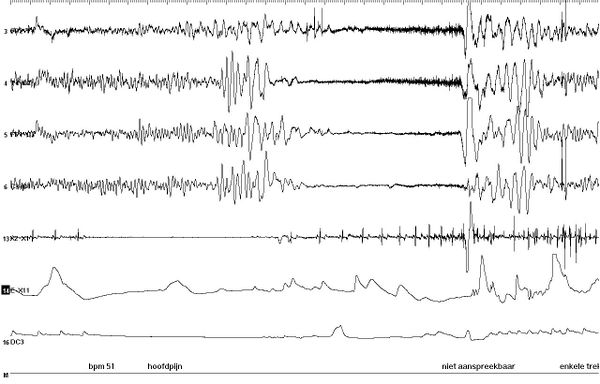EEG recordings during syncope: Difference between revisions
Jelledejong (talk | contribs) (Created page with "''J.G van Dijk* and W. Wieling§ Department of Neurology * , Leiden University Medical Centre Department of Medicine § , Academic Medical Centre, University of Amsterdam, Ams...") |
(No difference)
|
Revision as of 11:25, 22 November 2017
J.G van Dijk* and W. Wieling§ Department of Neurology * , Leiden University Medical Centre Department of Medicine § , Academic Medical Centre, University of Amsterdam, Amsterdam (The Netherlands)
Case Report

These are tilt table results from a 14-years old girl with recurrent vasovagal syncope. The period shown lasted 30 seconds and occurred 5 minutes after tilting. Blood pressure had already gradually dropped to 70/50 mm Hg and heart rate had slowed to 51 beats per minute, when asystole set in, lasting for 11 seconds. After about 7 seconds of asystole the EEG changed from a normal alpha rhythm to slow large delta waves, which lasted for about 4 seconds. Consciousness was lost. Then the EEG was flat for 7 seconds. The tilt table returned to the horizontal position in this period. The resumption of cortical activity started 9 seconds after the first heart beat following asystole. The EEG then changed in the reverse order. Some myoclonic jerks were observed, and can be recognised in the ECG channel. Only four EEG channels are shown (right frontal and occipital, left frontal and occipital). The ECG shows some movement artifacts. Blood pressure was measured with a Finapress device.
Editor's Comment
During syncope the EEG in our patient showed a progressive slowing with an increase in amplitude, followed by a sudden reduction of brain-wave amplitude, resulting in a "flat" EEG. The end of syncope was accompanied by changes in the reverse order, giving rise to a typical 'slow-flat-slow' pattern. Myoclonic jerks occurred during the slow and flat stages of the EEG. These findings are in concordance with observations following eyeball pressure and carotid sinus massage to induce abrupt onset asystolic syncope [1-6, for review see 6]. Asystole lasting 3-6 seconds produces no EEG abnormalities and almost no clinical symptoms, except possibly unclear thinking. However, after 7-13 seconds of asystole slow waves (theta and delta) appear, followed by abrupt flattening. This change is accompanied by rapid clouding and then complete loss of consciousness. With asystole longer than 10-14 seconds myoclonic jerks can be observed, sometimes followed by a generalized tonic spasm in extension and even opisthotonus, while on the EEG there is cortical silence [1-6]. EEG findings during presyncope and syncope induced by tilt-table testing [7] show similar, but more variable patterns than syncope induced by the fainting lark and eyeball pressure. The slower fall in systemic blood pressure during vasovagal syncope may be involved.
The myoclonic activity during a prolonged syncopal episode is postulated to originate from the reticular formation; a release phenomenon of the lower brainstem neurons no longer suppressed by higher centres is postulated [3]. It is, however, unknown why sometimes they do and sometimes they do not appear. Cerebral hypoxia has potent epileptogenic effects, therefore hyperventilation (causing cerebral vasoconstriction) is routinely used during EEG recordings to activate epileptic discharges [8]. Nevertheless, only a few EEG documented epileptic seizures evolving from syncope have been reported. Almost all of the cases involve young children. Only one adult case has been reported [6].
References
- Lempert T, Bauer M, and Schmidt D. Syncope: a videometric analysis of 56 episodes of transient cerebral hypoxia. Ann Neurol. 1994 Aug;36(2):233-7. DOI:10.1002/ana.410360217 |
-
Gastaut H, Fischer-Williams M. Electro-encephalographic study of syncope: its difference from epilepsy. Lancet 1957; 2: 1018-1025.
-
Gastaut H. Syncopes: generalized anoxic cerebral seizures. In: Magnus O, Haas AM eds. Handbook of clinical neurology. Vol 15. Chapter 42. Amsterdam: North Holland 1974: 815-836.
-
Stephenson JBP. Fits and faints. London: MAC Keith Press 1990
-
Stephenson JBP. Fainting and syncope. In Maria BL. Current management in pediatric neurology. Second edition. BC Decker, Hamilton: 2002, 345-351
- Brenner RP. Electroencephalography in syncope. J Clin Neurophysiol. 1997 May;14(3):197-209. DOI:10.1097/00004691-199705000-00004 |
- Sheldon RS, Koshman ML, and Murphy WF. Electroencephalographic findings during presyncope and syncope induced by tilt table testing. Can J Cardiol. 1998 Jun;14(6):811-6.
-
Flink R, Pedersen B, Guekht AB, Malmgren K, Michelucci R, Neville B, Pinto F, Stephani U, Ozkara C; Commission of European Affairs of the International League Against Epilepsy: Subcommission on European Guidelines. Related Articles, Links [Abstract] Guidelines for the use of EEG methodology in the diagnosis of epilepsy. International League Against Epilepsy: commission report. Commission on European Affairs: Subcommission on European Guidelines. Acta Neurol Scand 2002; 106: 1-7